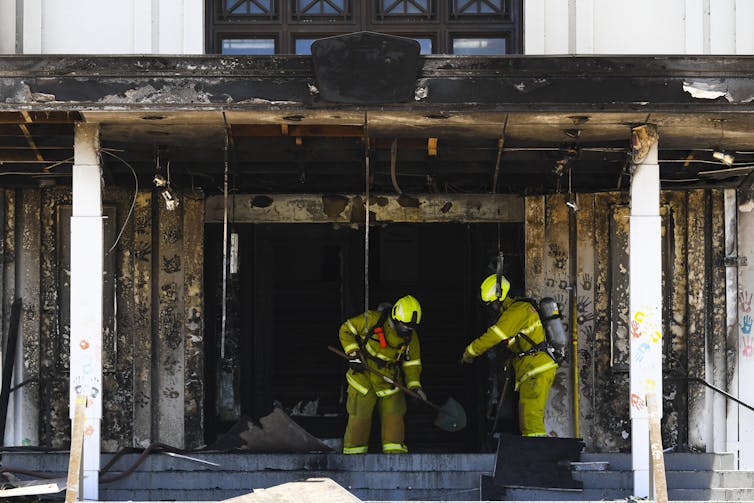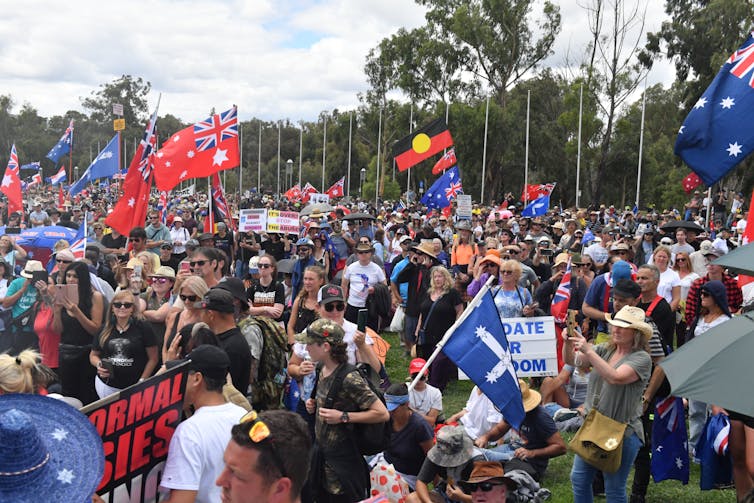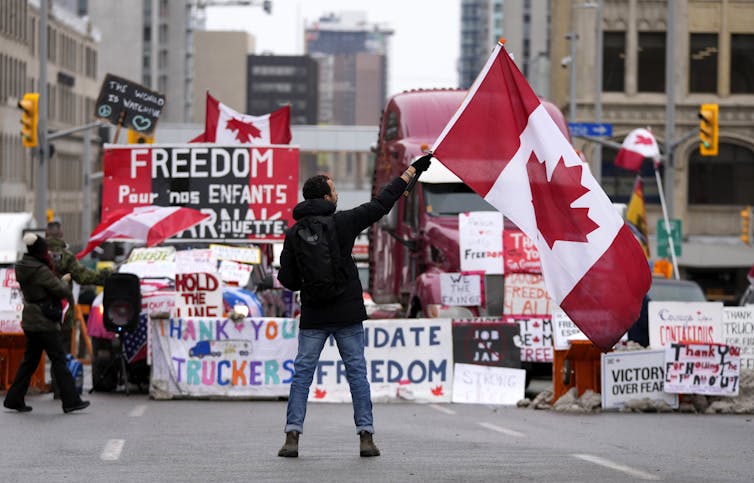Source: The Conversation (Au and NZ) – By Josh Roose, Senior Research Fellow, Alfred Deakin Institute, Deakin University
As the 2022 federal election draws nearer, there are many factors that may shape the outcome.
This is not Australia’s first experience of a pandemic, nor the first time this has played a role in state divisions and elections: the 1919 Spanish Influenza pandemic is a case in point.
However, this is the first election in which the immense economic and social damage of a pandemic has combined with a global far-right populist surge, an increase in far-right-wing extremism and the disruptive power of social media. The most recent and visible example is the so-called “Canberra convoy”, which has just concluded.
In seeking to understand the potential influence of these factors, we cannot look at any one of them in isolation; they have to be understood as part of a symbiotic relationship. This is evident when we look at the make-up of the protesters.
They first gathered at old Parliament House, site of the Aboriginal tent embassy, the longest protest for Indigenous rights anywhere in the world. There, the “sovereign citizen” protesters initially sought to cloak themselves in the legitimacy of Aboriginal calls for sovereignty. Shortly after, in December 2021, old Parliament House, which holds significance within some sovereign citizen conspiracy theories, was set on fire. Several people have been charged over the incident.While featuring a very small number of Indigenous activists, the fire and recently arrived protesters were roundly condemned by Aboriginal leaders at the Tent Embassy.
Since these events, anti-vaccine mandate protesters and other “freedom rally” protesters, including Q-Anon conspiracy theorists, militant wellness groups, religiously inspired actors and far-right extremists such as the Proud Boys, have converged on the nation’s capital. They have protested outside the old and new Parliament House, seeking to cause mass disruption.

Lukas Coch/AAP
Protesters on the ground are highly diverse. Many are keen to paint themselves as concerned “mums and dads”. Others frame their actions as an act of “love”, a pattern seen globally at “freedom” protests.
Indeed, many may be merely exercising their democratic right to protest.
However, it is important to understand that the ideological underpinnings of the freedom movement range from libertarianism to far-right ideologies. We need to move beyond the notion of anti-vaxxers as left-wing hippies from Brunswick or Byron Bay (though they may well be concentrated there).
Many from the “wellness” communities are educated, wealthy, hold strong convictions and are active consumers in a highly profitable enterprise.
Likewise, it is important to move beyond the association of the far right as black-clad, swastika-wearing skinheads (though some may be).
The modern far right is well organised and more sophisticated in its tactics (including the use of “citizen journalists”, memes and encrypted messaging applications). Most importantly, beyond the traditional neo-Nazi groups, it is multiracial. Restoring the “nation”, rather than race, to an imagined past greatness is central to their extremism.

Lukas Coch/AAP
This is evident in groups such as the Proud Boys, who are present at the Canberra protests, and who were led in the US until recently by Enrique Tarrio, a Cuban American. We have witnessed numerous Ustaše flags at the protests, representing a resurgent Croatian ultranationalist fascist and antisemitic organisation that was active during the second world war, perpetrating acts of genocide. The group also holds a wide variety of groups and individuals from QAnon conspiracy theorists and sovereign citizens (known for their use of the red ensign) to evangelical and Orthodox Christians. They represent a highly multicultural cluster who have opposed the use of vaccines from the earliest days of the pandemic.
Read more:
What is the Australian merchant navy flag, the red ensign? And why do anti-government groups use it?
Importantly, this broad coalition, and the far right in particular, must be understood as part of a transnational movement. Even a cursory analysis of protest message boards indicates the protesters have been heavily influenced by groups and events overseas. They share a common vocabulary and symbology.
It is clear the January 6 2021 storming of the Capitol Building in the United States, and the more recent Ottawa “freedom convoy”, described by Ottawa police as a “threat to democracy”, have inspired some protesters.

Justin Tang/AP/AAP
Many actors within these movements have track records of violent rhetoric and extremist sentiment, and the threat of future violence cannot be discounted. Indeed, it must be considered likely.
These movements must be also be understood as associated with the global right-wing populist surge that has resulted in the election of authoritarian governments, led by “strong men”, in countries ranging from the United States, Hungary and Poland to the Philippines, India and Brazil.
These leaders claim to speak for the “people”, framing themselves as outsiders to a corrupt and broken political system. They promise to deliver radical change, though merely aim to replace the current powers. We saw this most famously with Donald Trump’s promise to “drain the swamp”.
While a key element of winning democratic elections is indeed to be the most “popular” party, far-right authoritarian populists prey on social division and seek to exploit anger and fear to gain political capital. We see this in the actions of United Australia Party leader Craig Kelly and some fringe members of the Liberal Party such as George Christensen. These men have sought to frame themselves as champions of the protest movement, but their actions may be understood as cynically stoking social division for political gain.
In this case, the prize is seats in parliament and the potential to hold the balance of power, forcing major parties to negotiate favourable outcomes for mining magnate Clive Palmer, via the United Australia Party.
In the Canberra convoy, we are witnessing the consolidation of an alliance between diverse, yet highly political, groups infected with conspiracy and far-right ideas. They then intersect with right-wing populist politicians intent on exploiting these events for political gain.
This is, in many respects, new ground in Australian politics. The question remains as to how successful this alliance will be at the ballot box.
![]()
Josh Roose is part of a project funded by The Australian Research Council: ‘Far Right in Australia: Intellectuals, Masculinity and Citizenship’ (DP200102013).
– ref. How ‘freedom rally’ protesters and populist right-wing politics may play a role in the federal election – https://theconversation.com/how-freedom-rally-protesters-and-populist-right-wing-politics-may-play-a-role-in-the-federal-election-176533







